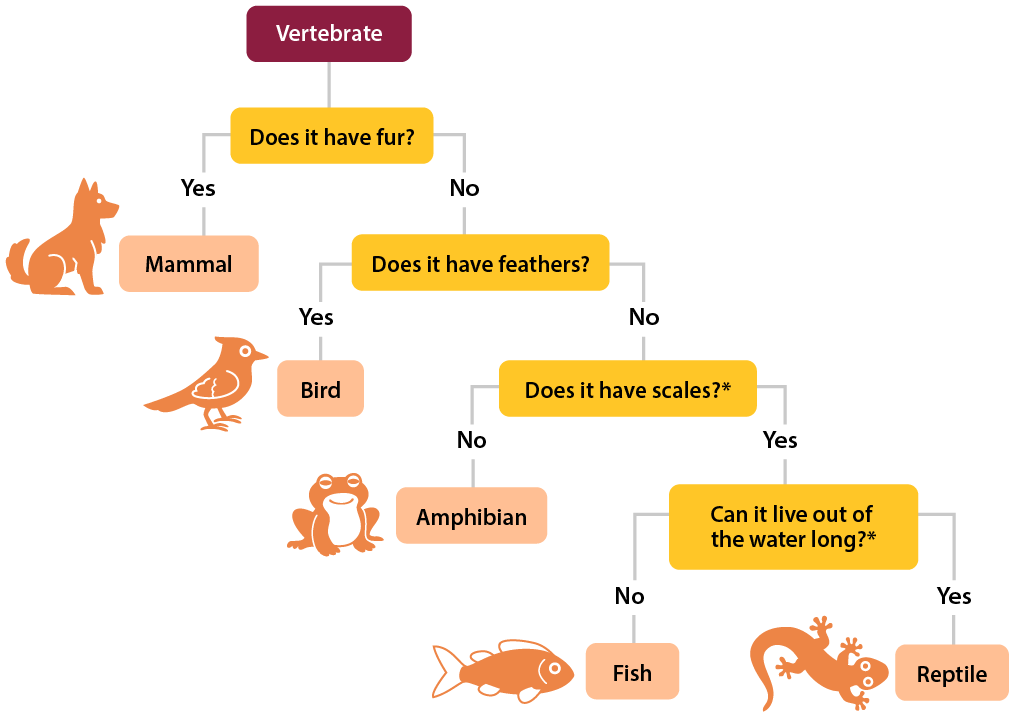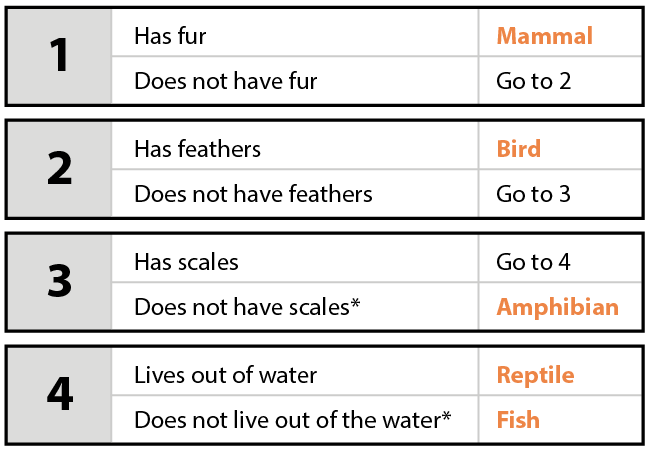Introduction
Identification Keys
You're walking along a path in the forest. On the ground, through a gap in the leaves, you see a small animal you've never seen before. Moving slowly and quietly so as not to scare it, you creep closer to get a better look. You notice it doesn't have any fur, or any feathers. It has four legs, and its skin appears shiny and wet. You wonder what it could be.
When you see an animal you've never seen before, the features you observe are clues that can help you identify it. Those features will let you use a tool called a species identification key. Identification keys help us to classify living things such as plants and animals to figure out what they are.
Below are two examples of simple identification keys. These are both for vertebrates, which are animals with a backbone. These two keys cover the same information, but they are displayed in two different formats. Scientists use either Tree Identification Keys, which look like a flow chart, or A/B Identification Keys, which look like a list.
Tree Identification Key

AB Identification Key

*These questions are just being used as examples. They won’t always let you divide up these animals correctly. For example, not all fish have scales. So in this tree, an eel might be classified as an amphibian, when it’s actually a fish.
Now It's Your Turn!
To practice using these identification keys, think about a type of animal that you know has a backbone. Start at the top of the Tree Identification Key and answer each question until you arrive at an answer. Does the animal you picked belong in this group? If not, go back through the key to see where you made a mistake. Next, pick a new animal with a backbone and practice using the A/B Identification Key.
Identifying Fish
Now that you know the basics about identification keys, it's time to play the game! In this game you will be a marine biology intern working in Bermuda. You and your team are focused on identifying fish and plankton found around the island. You have identification keys for both, but sometimes keys require some base knowledge. Before you use the keys, you must learn how to distinguish the different features of the organisms so that you know which branch of the key to select. Learning how to accurately describe the organism will help you to correctly identify it.
Look at the image of the fish below. How would you describe it? What features does it have?
You probably noticed that the body is elongated, like a rod, and the color is reddish brown. It also has a long, tubular mouth and a fan shaped tail. If you look closely you will also see thin horizontal stripes and small spots covering the body. These are all features that can be used to help identify this fish as a trumpetfish.
Identifying Plankton
Once you master identifying fish, you move on to help your team classify the plankton samples. Plankton are any plants or animals that drift through the water and are unable to swim against a current. Many plankton are microscopic, meaning you need a microscope to see them, while others are quite large. Did you know that jellyfish are plankton? Animal plankton are called zooplankton and plant plankton are called phytoplankton.
Plankton are normally caught with a net which is dragged behind a boat. The net has a very fine mesh which traps the plankton while allowing the water to pass through. Your team uses a cone shaped net to catch zooplankton. After collection, you view the zooplankton under a microscope to look at their features while using the identification key.